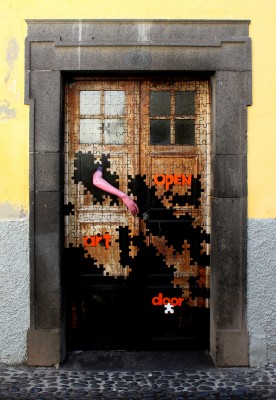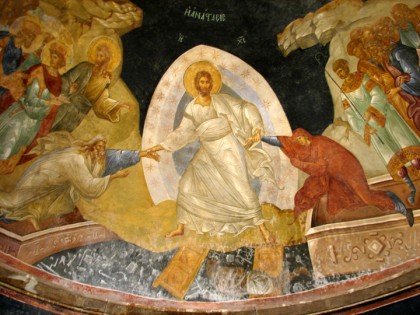 God is one. Love God with all your heart, mind, and soul, and love your neighbor as yourself. –Jesus, according to Mark.
God is one. Love God with all your heart, mind, and soul, and love your neighbor as yourself. –Jesus, according to Mark.
Sir Tim Berners-Lee, the man who created the World Wide Web, spoke on a TED talk on NPR about Open Sourcing, the freedom from copyright, royalties, and all intellectual property rights into which Berners-Lee has dedicated the Web.
Open Source makes available to the world all the codes and design language used in the Web project. The principle in doing this is that creating things freely and openly will lead to possibilities never imagined by the original author. And this is what has happened with the World Wide Web. Through Open Sourcing, it has grown exponentially and swiftly, into a global communication and conversation that is without parallel in the history of the world.
Open Source is a radically democratic concept. It reverses the entire western model of production, in which designs have been closely guarded secrets, but products have been sent out around the world, for a price. Open Source shares designs and encourages alterations, feedback, and the making of products from the designs, everywhere. Ideas, like seeds, are strown throughout the World Wide Web, to grow as they can, everywhere.
 The possibilities of Open Sourcing are limitless. It is currently being used in projects as disparate as expanding democratic participation in Argentina, and exploring the world’s oceans with robots available at no cost through a starter kit that can then be modified to fit each geographic situation.
The possibilities of Open Sourcing are limitless. It is currently being used in projects as disparate as expanding democratic participation in Argentina, and exploring the world’s oceans with robots available at no cost through a starter kit that can then be modified to fit each geographic situation.
Surely Jesus was an Open Source guy. He gave anyone and everyone his design: love God, who is One, with all your heart, mind and soul; and love your neighbor, who is one with you, as you love yourself. He sent out disciples in teams to spread the news, trusting the inevitable variations, and promised to send his Spirit to empower people to communicate across all barriers-of languages, cultures, anxieties, enmities.
Take it and run with it: this is his continued blessing. And the obstacles to that blessing are always the same: our desire for private ownership, and our desire to keep change at bay, to keep producing things the same way. These obstacles exist in our uneasy recognition of the larger Oneness, which we often choose to fear rather than to love. Think of the enemies we make, too many to count, whome we want to keep out of the larger Oneness. Think of the continual tension in which we exist about where to send the troops and when. Think of our fraught relationship with Mother Earth, and the agonizingly slow process of bringing nations into meaningful conversation about environmental destruction. Think of the loathing we currently feel towards compromise, the action that lets people with whom we disagree and people we dislike participate in the design of our common life. 
Equally, these obstacles exist inside ourselves. Purity of heart, Kierkegard wrote, is to will one thing. Yet we rarely do. We are only infrequently able to love ourselves well enough to extend goodwill to those who really need it, rather than only to those from whom we expect to get something. And this confusion in us so often leaves us incapable of largeness of heart, mind, soul, and vision.
My niece, Anni, has introduced me to a young writer, Abby Mumford, who has written winsomely in her blog My Mumblings about stumbling on a book written by her grandfather, a rocket scientist. It made her feel inadequate, to say the least, till she discovered:
I might have something in common with those ridiculously smart rocket scientists: failure.

From her grandfather’s scientific writing Abby grasps that he made progress always, and only, through his failures, through studying them, and trying again, intent on avoiding making the same mistakes, and open to new errors and more trials. Abby writes:
I’m really good at failing, especially of late. I’ve failed to buy a condo. I’ve failed to keep a car in working condition. I’ve failed to stop snacking on every single thing within my reach. I’ve failed to get a good night’s sleep (any night of the week). . . I’ve failed to feel something other than loneliness. I’ve failed to write anything worth publishing. I’ve failed to write anything merely for my own amusement. I’ve failed to even try. As the failures piled up, I’ve been unable to see anything else.
Depending on how you look at it, this is an epiphany – or a moment of redemption. Maybe both. Accepting her oneness with the old man who accomplished a kind of work she cannot do, Abby is then able to move on from the ash heap of her failures, and to feel hopeful about life again. Abby, again:
To study something so you don’t make the same mistake again? Getting dirty as you crawl around in the dirt gathering every minuscule piece and particle (of what blew up)? That is hard work. That is what it takes to succeed.
And so I will scrounge up the messy parts of my life, put them on a petri dish, and slide that under the microscope for further studying. Whoa, look at how scientific I already am!
 Jesus thought so, too. He praised the young Pharisee, who was part of a movement that tried so hard to do everything right, to follow the ritual design for life to the letter and so to please God – when the young man said, Wow! Loving God and your neighbor is so much more important than all the sacrifices and rituals (duties?) we make. This was a soul conversion, from individual achievement within a group that looks and acts alike, to joining of hearts and minds in goodwill, in a diverse world that cannot begin to imagine the future to which it is being drawn.
Jesus thought so, too. He praised the young Pharisee, who was part of a movement that tried so hard to do everything right, to follow the ritual design for life to the letter and so to please God – when the young man said, Wow! Loving God and your neighbor is so much more important than all the sacrifices and rituals (duties?) we make. This was a soul conversion, from individual achievement within a group that looks and acts alike, to joining of hearts and minds in goodwill, in a diverse world that cannot begin to imagine the future to which it is being drawn.
Scientists, it seems, do understand that they need each other in order to achieve anything. And that’s an argument for Open Sourcing, which is an invitation to Oneness, in which love can bloom and grow.
__________________________________________________________
Illustrations:
1. One door in the ArT of opEN Doors Project, 2012, Funchal, Portugal. Vanderbilt Divinity School Library, Art in the Christian Tradition.
2. Love Your Enemies, Part of a street art initiative in Ithaca NY, 2008. Vanderbilt Divinity School Library, Art in the Christian Tradition.
3. Anastasis, Christ with Adam and Eve, Kariye Museum, Istanbul, Turkey, 1310. Vanderbilt Divinity School Library, Art in the Christian Tradition.
4. Annunciation to the Shepherds, 1410, Limbourg, Jean de, Musee Conde, Chantilly, France. Vanderbilt Divinity School Library, Art in the Christian Tradition.
5. Goodwill Metal Relief. 2000. Washington, DC. Vanderbilt Divinity School Library, Art in the Christian Tradition.










